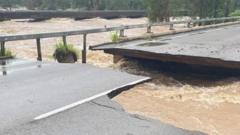Recently, significant sections of a crucial highway in Queensland have given way due to worsening floods, following record-breaking rainfall. At least one person has lost their life, and thousands have been driven from their homes, particularly affecting Townsville, Ingham, and Cardwell, areas now grappling with severe weather conditions. The Bureau of Meteorology warns that unprecedented downpours are expected to continue, as some locations have received over 1.3m (4.2ft) of rain since Saturday. Consequently, rivers and dams are overflowing, resulting in extensive flooding.
Prime Minister Anthony Albanese, who received updates on the flooding response Monday, praised the resilience and solidarity shown by Australians during this disaster. He noted the ongoing risk from floodwaters is expected to endure for several days. Emergency efforts aimed at reaching the most impacted areas have been complicated by the collapse of sections of Bruce Highway, a critical transport route linking Brisbane to regional hubs, which now poses an additional detour of approximately 700km (434 miles) for transporters.
Queensland Premier David Crisafulli expressed his sympathies to the compact town of Ingham following the tragic death of a 63-year-old woman in a rescue operation. He emphasized the necessity for residents in the flood zones, particularly within six suburbs of Townsville, to refrain from returning home until authorities declare it safe, as threats from the Ross River remain significant.
Reports indicate that the region has experienced six months' worth of rainfall in just three days, leading to warnings that up to 2,000 homes may face flooding. Major flood alerts continue to be active for several rivers throughout the region.
Emergency services are on high alert, having received 480 calls for assistance overnight and conducting multiple water rescues. Many communities are suffering from power outages, making communication difficult. Authorities are urging residents to stay alert and support each other in these challenging times. Currently, around 400 individuals are taking refuge in evacuation centers across the affected towns.
Experts believe that North Queensland, already susceptible to cyclones and flooding, is likely facing a future with more frequent and intense weather events due to climate change impacts. Meteorologists suggest that these floods could be the most severe the area has faced in over six decades.
Prime Minister Anthony Albanese, who received updates on the flooding response Monday, praised the resilience and solidarity shown by Australians during this disaster. He noted the ongoing risk from floodwaters is expected to endure for several days. Emergency efforts aimed at reaching the most impacted areas have been complicated by the collapse of sections of Bruce Highway, a critical transport route linking Brisbane to regional hubs, which now poses an additional detour of approximately 700km (434 miles) for transporters.
Queensland Premier David Crisafulli expressed his sympathies to the compact town of Ingham following the tragic death of a 63-year-old woman in a rescue operation. He emphasized the necessity for residents in the flood zones, particularly within six suburbs of Townsville, to refrain from returning home until authorities declare it safe, as threats from the Ross River remain significant.
Reports indicate that the region has experienced six months' worth of rainfall in just three days, leading to warnings that up to 2,000 homes may face flooding. Major flood alerts continue to be active for several rivers throughout the region.
Emergency services are on high alert, having received 480 calls for assistance overnight and conducting multiple water rescues. Many communities are suffering from power outages, making communication difficult. Authorities are urging residents to stay alert and support each other in these challenging times. Currently, around 400 individuals are taking refuge in evacuation centers across the affected towns.
Experts believe that North Queensland, already susceptible to cyclones and flooding, is likely facing a future with more frequent and intense weather events due to climate change impacts. Meteorologists suggest that these floods could be the most severe the area has faced in over six decades.




















